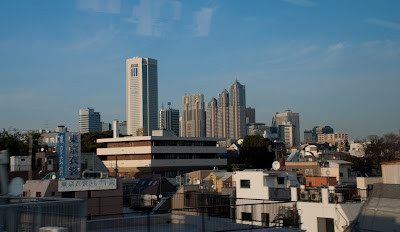Gunma certainly doesn't have a lock on gorgeous mountain scenery and active volcanoes with plenty of boiling water flowing out of the ground. One of the more famous mountain getaways in the greater Kanto region is the resort area of Hakone.
Hakone is a short express ride south west of Tokyo, close to Mt. Fuji. In fact, Mt. Fuji is one of the big draws of the Hakone region. The spectacular views of Japans most famous mountain is a big draw to tourists from around the country and the world. Though as it is said, Mt. Fuji is a very shy mountain, and it may not always make itself available for photography.
Hakone itself is located in an ancient caldera. Twice before a volcano has risen here, exploded and then collapsed. Today there is a smouldering central peak surrounded by deep valleys and a beautiful lake system. The prescribed way to enjoy Hakone is to make a multi-mode transit loop around the central cone, starting with a very cute narrow gauge railroad. The route from the plains below is so steep that the train must make three switchbacks on the way up, swapping back for front three times.
The next step is a cable car right up the side of the mountain. It was quite a bit of fun to watch the funicular system in action, with the cable slowly lowering the car down to the bottom station, then pulling it (and us)back up past the counterweight car.
It is here that the most spectacular part of the journey begins. A gondola system that carries people up and over a hissing field of sulfur vents, and then crests a ridge and presents visitors with the splendor of Mt. Fuji and its perfectly shaped cone. Unfortunately for us, while the view was still tremendous, Fuji-san was feeling a little shy, and the summit was wreathed in clouds. Though we did have a nice view of the sunlight glittering off of the far away ocean.
The next step in the course was one we were unable to take. There are "pirate ships" that take you around the lake, but we were there a little late in the day and things were starting to shut down. It is hard to imagine just why the closing time of the ropeway was an hour before sunset, but Japan is known for having some pretty early closing times. At least, to my western eyes. (Sometimes I want to go grocery shopping past 8pm.)

Though I have yet to mention the best part of the whole trip, our hotel. While there are many options for staying in Hakone, from the dirt cheap to the excessively luxurious, there is only one hotel that is historic enough to be mentioned on the guide map on the wall in the train. The Fujiya hotel was founded in 1891, and is the oldest western style hotel in Japan. Previous guests include the Archduke Franz Ferdinand of Austria, Charlie Chaplin, The Emperor of Japan, John Lennon and Yoko Ono. That is a pretty illustrious list. The hotel has grown remarkably over the years, and now covers a wide area with several eras of architecture represented.

Rooms in the oldest, most historical, and least luxurious part of the hotel are remarkably affordable, especially considering the country and the area. So we were thrilled to get a chance to stay there. The mix of Western and Japanese styles that typifies Meiji period architecture is fascinating and very beautiful. The interior of the main building is all old wood of a rich dark brown, something that you don't see much of in the modern Japan of bland, drab concrete. Like most resort areas in Japan, Hakone is an onsen town. Fujiya approached the onsen hotel role very differently from most. Rather than have a huge and gorgeously appointed public bath, they just piped onsen water to every room. Every room is its own private hot springs bath.
We didn't have dinner at the hotel, that was a bit beyond our budget, but our room came with breakfast included. Now, I love Japan. I really do. But I do not love Japanese notions of breakfast. Rice, miso soup, and grilled fish does not make for an appealing first meal for me. Neither does spaghetti and fried chicken. The weak coffee, terrible toast and a spot of jam that you sometimes find is almost insulting. Natto for breakfast moves from insulting to downright ludicrous.
All of that is to say that the breakfast buffet at Fujiya was amazing. It was the best that I have ever encountered anywhere in the country. We had freshly prepared omelets, bowls of fruit and yogurt, fresh good bread and rolls, bacon, sausage, eggs, cereal and plenty of good coffee to wash it all down with. I had to be very careful to not just shovel it all in my mouth as quickly as I could, and to try and savor this watershed.
So, properly fortified by breakfast, we headed downhill into the nearby town of Odawara, eager to add a new castle to my list.






































